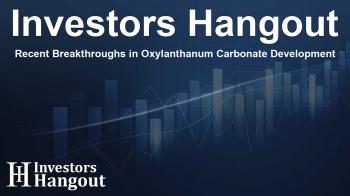Recent Breakthroughs in Oxylanthanum Carbonate Development

Exciting News from Unicycive Therapeutics
Unicycive Therapeutics, Inc. (NASDAQ: UNCY) is making strides in the biotechnology field, especially in developing effective therapies for kidney disease. Recently, the company celebrated a significant milestone with its oxylanthanum carbonate (OLC) Phase 1 dose escalation study. The findings have been published in the peer-reviewed journal, Clinical and Translational Science, marking an exciting moment for both the company and the treatment of hyperphosphatemia.
Understanding the OLC Dose-Escalation Study
The publication, titled "Safety and Phosphate-Binding Capacity of Oxylanthanum Carbonate in Healthy Volunteers," provides valuable insights into the efficacy and safety of OLC. This trial involved healthy participants and tested various doses of OLC: 500 mg, 1,000 mg, 1,500 mg, and 2,000 mg. Remarkably, OLC demonstrated high tolerance among the participants and effectively reduced phosphate absorption, as evidenced by decreased urinary phosphorus excretion during treatment.
The Importance of These Findings
Dr. Shalabh Gupta, the Chief Executive Officer of Unicycive, expressed satisfaction with the safety findings related to OLC and the prestigious publication of the study. This data is critical as it contributes to the New Drug Application (NDA) for OLC, which is currently under FDA review. The NDA aims to bring this innovative treatment one step closer to healthcare settings.
Study Details and Results
The OLC study was conducted with 32 participants, administering doses three times daily over four days. Participants were randomized to receive either OLC swallowable tablets or a placebo. The study principally focused on safety, but also explored the drug's phosphate binding capabilities. Importantly, the findings indicated no serious adverse events or complications arose during treatment.
Innovative Approach to Phosphate Binding
Oxylanthanum carbonate sets itself apart as a next-generation phosphate-binding agent using advanced nanoparticle technology. Its development targets patients with chronic kidney disease (CKD) experiencing hyperphosphatemia—a condition where phosphate levels are dangerously high. Due to its unique composition, OLC has the potential to enhance patient compliance and reduce pill burdens. In today's fast-paced world, a lower number of pills can significantly improve adherence to treatment regimens.
Market Opportunities and Challenges
The global market for treating hyperphosphatemia is substantial, estimated to be over $2.28 billion, with North America accounting for more than $1 billion of this estimate. Despite multiple FDA-approved medications available, a staggering 75% of U.S. dialysis patients struggle to meet the recommended phosphorus levels as indicated by medical guidelines.
Addressing Hyperphosphatemia: A Serious Need
Hyperphosphatemia poses severe risks, particularly for patients suffering from End Stage Renal Disease (ESRD). If left unmanaged, it can lead to further complications, including cardiovascular disease and renal osteodystrophy. These risks underline the urgent need for effective treatment solutions like OLC to address the condition.
Company's Vision and Future Directions
Unicycive is committed to securing FDA approval for OLC. The NDA submission includes extensive data from three critical clinical studies and thorough preclinical data analysis. The drug is safeguarded by a robust patent portfolio, ensuring exclusivity until at least 2031, with potential extensions until 2035 following FDA approval.
Looking Ahead
Unicycive's second asset, UNI-494, is also in clinical development for treating acute kidney injuries, showing promise in early Phase 1 results. This reflects the company's continued dedication to advancing treatments for renal diseases and underscores the importance of research in improving patient outcomes.
Frequently Asked Questions
What is Oxylanthanum Carbonate?
Oxylanthanum carbonate is a phosphate-binding agent developed by Unicycive Therapeutics aimed at treating hyperphosphatemia in patients with chronic kidney disease.
What were the results of the Phase 1 study?
The Phase 1 study showed OLC to be well tolerated and effective in reducing urinary phosphorus excretion, indicating its potential safety and efficacy.
Why is hyperphosphatemia a concern for kidney patients?
Hyperphosphatemia can lead to serious complications like cardiovascular disease and renal osteodystrophy if not effectively managed.
What are the next steps for Unicycive Therapeutics?
Unicycive is actively seeking FDA approval for OLC and working on additional clinical trials to advance its pipeline of kidney disease treatments.
How does OLC differ from existing treatments?
OLC offers a potential best-in-class profile with a lower pill burden, improving adherence for patients compared to currently available treatments.
About Investors Hangout
Investors Hangout is a leading online stock forum for financial discussion and learning, offering a wide range of free tools and resources. It draws in traders of all levels, who exchange market knowledge, investigate trading tactics, and keep an eye on industry developments in real time. Featuring financial articles, stock message boards, quotes, charts, company profiles, and live news updates. Through cooperative learning and a wealth of informational resources, it helps users from novices creating their first portfolios to experts honing their techniques. Join Investors Hangout today: https://investorshangout.com/
Disclaimer: The content of this article is solely for general informational purposes only; it does not represent legal, financial, or investment advice. Investors Hangout does not offer financial advice; the author is not a licensed financial advisor. Consult a qualified advisor before making any financial or investment decisions based on this article. The author's interpretation of publicly available data shapes the opinions presented here; as a result, they should not be taken as advice to purchase, sell, or hold any securities mentioned or any other investments. The author does not guarantee the accuracy, completeness, or timeliness of any material, providing it "as is." Information and market conditions may change; past performance is not indicative of future outcomes. If any of the material offered here is inaccurate, please contact us for corrections.
